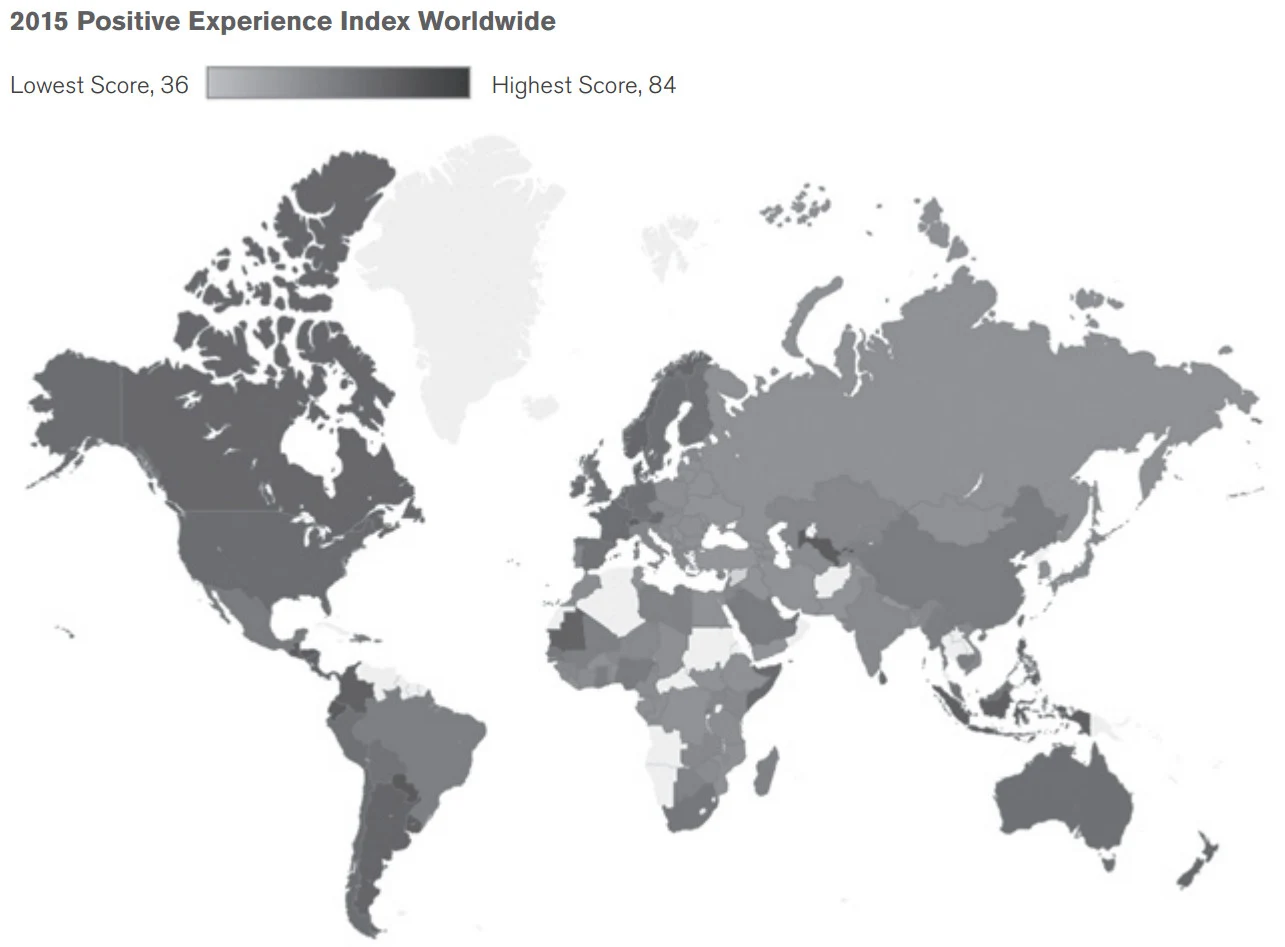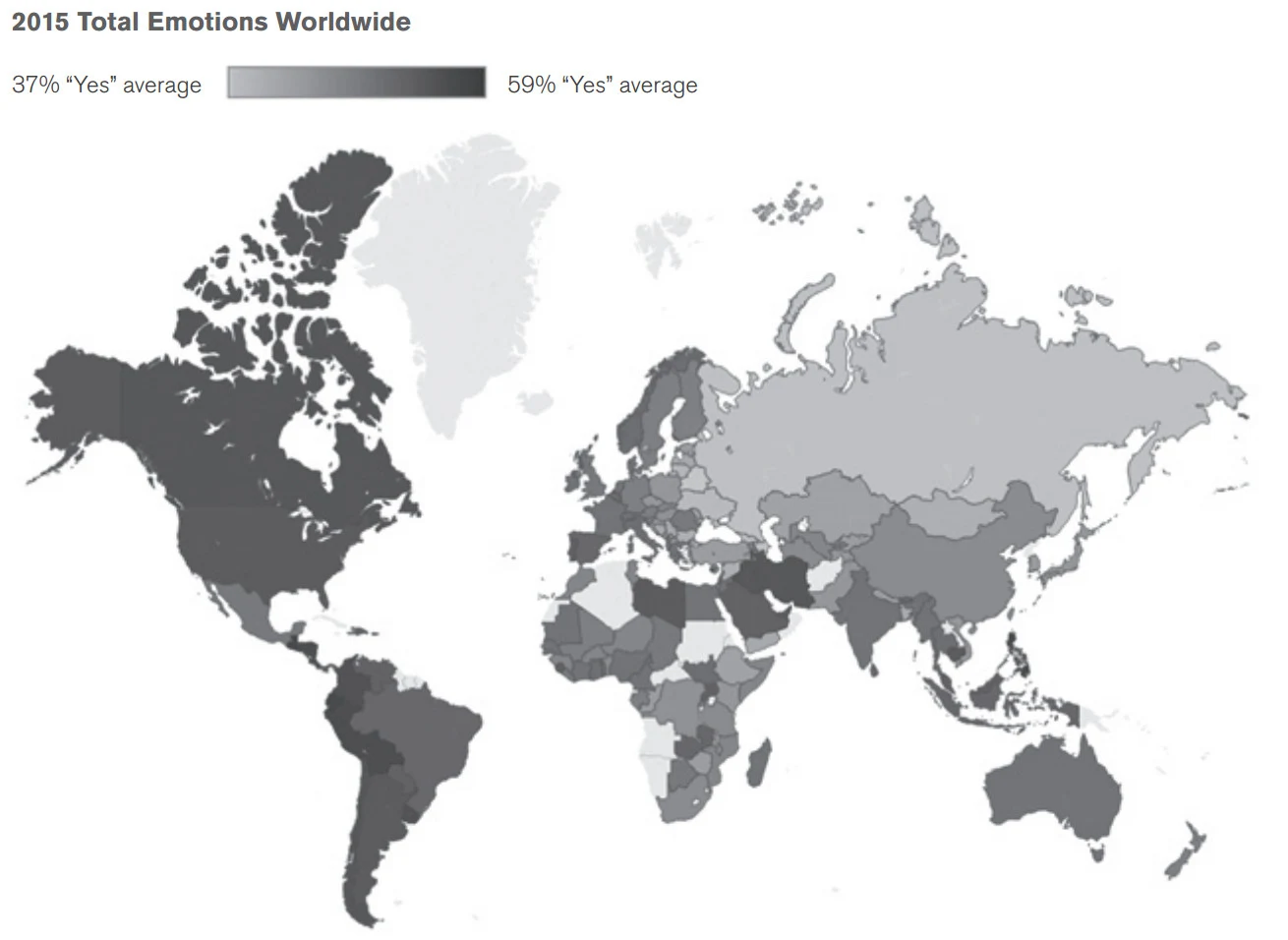The Global Emotions 2016 report presents the results from Gallup’s latest measurements of people’s positive and negative daily experiences, based on nearly 147,000 interviews in 2015 with adults in 140 countries.
Positive Experience Index Questions
• Did you feel well-rested yesterday?
• Were you treated with respect all day yesterday?
• Did you smile or laugh a lot yesterday?
• Did you learn or do something interesting yesterday?
• Did you experience the following feelings during a lot of the day yesterday?
The Positive Experience Index score is the mean of all valid affirmative responses to these items multiplied by 100. County-level index scores range from zero to 100. Higher scores mean that positive emotions are more pervasive in a country. These scores strongly relate to people’s perceptions about their living standards, personal freedoms and the presence of social networks.
Negative Experience Index Questions
• Did you experience the following feelings during a lot of the day yesterday?
How about physical pain?
• Did you experience the following feelings during a lot of the day yesterday?
How about worry?
• Did you experience the following feelings during a lot of the day yesterday?
How about sadness?
• Did you experience the following feelings during a lot of the day yesterday?
How about stress?
• Did you experience the following feelings during a lot of the day yesterday?
How about anger?
The Negative Experience Index score is the mean of all valid affirmative responses to these items multiplied by 100. Country-level index scores range from zero to 100. The higher the score, the more pervasive negative emotions are in a country. People’s experiences with health problems and their ability to afford food are predictive of higher negative scores.
Gallup asked adults in 140 countries in 2015 if they had five positive experiences on the day before the survey. More than 70% of people worldwide said they experienced a lot of enjoyment, smiled or laughed a lot, felt well-rested and felt treated with respect. Additionally, 51% of people said they learned or did something interesting the previous day.
Latin American countries — and many of the same countries that topped the list in 2014 — dominate the list of countries in 2015 where adults are experiencing a lot of positive emotions each day. The only countries outside this region that top this list are Uzbekistan, Indonesia and Switzerland.
Highest Positive Experiences Worldwide, 2015
Paraguay 84
Guatemala 83
Honduras 83
Uzbekistan 83
Ecuador 83
El Salvador 82
Indonesia 82
Costa Rica 81
Uruguay 81
Colombia 81
Switzerland 81
Personal freedom and the presence of social networks are also highly predictive of scores on the Positive Experience Index, the latter of which helps to explain why people from poor countries in Latin America still seem to live such positive lives.
This relationship also helps explain some of the countries at the bottom of the list. Syria — long mired in civil war — has occupied the bottom spot on this list every year it was measured since 2012. In fact, several of the countries at the bottom of the list — Ukraine, Iraq, Yemen, Turkey and Syria — have ongoing internal and external conflict in common. In Nepal’s case, the devastating earthquake last year compounded the country’s already fragile situation.
Lowest Positive Experiences Worldwide, 2015
Syria 36
Turkey 51
Nepal 51
Georgia 54
Serbia 54
Iraq 54
Yemen 55
Bosnia and Herzegovina 55
Lithuania 55
Belarus 55
Ukraine 55
Most of the World Still Laughing, Smiling a Lot
Majorities in nearly all countries worldwide say they smiled or laughed a lot during the day before the interview in 2015. On average, 72% of people worldwide reported doing this the previous day. In only seven countries — Ukraine, Iraq, Turkmenistan, Nepal, Serbia, Syria and Turkey — did these numbers fall to 50% or lower.
Negative Experience Index on Higher End Globally in 2015
In 2015, Gallup asked adults in 140 countries if they had five different negative experiences on the day before the survey. More than one in three people said they experienced a lot of worry (36%) or stress (35%), and nearly three in 10 experienced a lot of physical pain (28%). At least one in five experienced sadness (21%) or anger (20%). All percentages increased between 2014 and 2015.
Highest Negative Experience Index Scores, 2015
Iraq 58
Iran 50
South Sudan 46
Syria 46
Cyprus 42
Liberia 41
Togo 40
Sierra Leone 40
Bolivia 40
Portugal 40
Palestinian Territories 40
Lowest Negative Experience Index, 2015
Uzbekistan 12
Russia 13
Kazakhstan 16
Kyrgyzstan 17
Taiwan 17
Belarus 18
Somalia 18
Singapore 18
Mongolia 19
Estonia 19
Highest Emotions Worldwide, 2015
Ecuador 59%
El Salvador 59%
Guatemala 59%
Philippines 59%
Nicaragua 58%
Honduras 58%
Peru 58%
Bolivia 58%
Costa Rica 57%
Uruguay 57%
Colombia 57%
Ecuador, El Salvador, Guatemala and the Philippines top the list of the most emotional countries in the world in 2015. On average, nearly six in 10 residents in each of these countries reported experiencing positive or negative emotions the previous day.
Countries with ties to Russia and the former Soviet Union largely dominate the list of countries at the other end of the spectrum, where fewer than four in 10 residents reported experiencing any of these feelings.
Via gallup.com
Positive Experience Index Questions
• Did you feel well-rested yesterday?
• Were you treated with respect all day yesterday?
• Did you smile or laugh a lot yesterday?
• Did you learn or do something interesting yesterday?
• Did you experience the following feelings during a lot of the day yesterday?
The Positive Experience Index score is the mean of all valid affirmative responses to these items multiplied by 100. County-level index scores range from zero to 100. Higher scores mean that positive emotions are more pervasive in a country. These scores strongly relate to people’s perceptions about their living standards, personal freedoms and the presence of social networks.
Negative Experience Index Questions
• Did you experience the following feelings during a lot of the day yesterday?
How about physical pain?
• Did you experience the following feelings during a lot of the day yesterday?
How about worry?
• Did you experience the following feelings during a lot of the day yesterday?
How about sadness?
• Did you experience the following feelings during a lot of the day yesterday?
How about stress?
• Did you experience the following feelings during a lot of the day yesterday?
How about anger?
The Negative Experience Index score is the mean of all valid affirmative responses to these items multiplied by 100. Country-level index scores range from zero to 100. The higher the score, the more pervasive negative emotions are in a country. People’s experiences with health problems and their ability to afford food are predictive of higher negative scores.
Gallup asked adults in 140 countries in 2015 if they had five positive experiences on the day before the survey. More than 70% of people worldwide said they experienced a lot of enjoyment, smiled or laughed a lot, felt well-rested and felt treated with respect. Additionally, 51% of people said they learned or did something interesting the previous day.
Latin American countries — and many of the same countries that topped the list in 2014 — dominate the list of countries in 2015 where adults are experiencing a lot of positive emotions each day. The only countries outside this region that top this list are Uzbekistan, Indonesia and Switzerland.
Highest Positive Experiences Worldwide, 2015
Paraguay 84
Guatemala 83
Honduras 83
Uzbekistan 83
Ecuador 83
El Salvador 82
Indonesia 82
Costa Rica 81
Uruguay 81
Colombia 81
Switzerland 81
Personal freedom and the presence of social networks are also highly predictive of scores on the Positive Experience Index, the latter of which helps to explain why people from poor countries in Latin America still seem to live such positive lives.
This relationship also helps explain some of the countries at the bottom of the list. Syria — long mired in civil war — has occupied the bottom spot on this list every year it was measured since 2012. In fact, several of the countries at the bottom of the list — Ukraine, Iraq, Yemen, Turkey and Syria — have ongoing internal and external conflict in common. In Nepal’s case, the devastating earthquake last year compounded the country’s already fragile situation.
Lowest Positive Experiences Worldwide, 2015
Syria 36
Turkey 51
Nepal 51
Georgia 54
Serbia 54
Iraq 54
Yemen 55
Bosnia and Herzegovina 55
Lithuania 55
Belarus 55
Ukraine 55
Most of the World Still Laughing, Smiling a Lot
Majorities in nearly all countries worldwide say they smiled or laughed a lot during the day before the interview in 2015. On average, 72% of people worldwide reported doing this the previous day. In only seven countries — Ukraine, Iraq, Turkmenistan, Nepal, Serbia, Syria and Turkey — did these numbers fall to 50% or lower.
Negative Experience Index on Higher End Globally in 2015
In 2015, Gallup asked adults in 140 countries if they had five different negative experiences on the day before the survey. More than one in three people said they experienced a lot of worry (36%) or stress (35%), and nearly three in 10 experienced a lot of physical pain (28%). At least one in five experienced sadness (21%) or anger (20%). All percentages increased between 2014 and 2015.
Highest Negative Experience Index Scores, 2015
Iraq 58
Iran 50
South Sudan 46
Syria 46
Cyprus 42
Liberia 41
Togo 40
Sierra Leone 40
Bolivia 40
Portugal 40
Palestinian Territories 40
Lowest Negative Experience Index, 2015
Uzbekistan 12
Russia 13
Kazakhstan 16
Kyrgyzstan 17
Taiwan 17
Belarus 18
Somalia 18
Singapore 18
Mongolia 19
Estonia 19
Highest Emotions Worldwide, 2015
Ecuador 59%
El Salvador 59%
Guatemala 59%
Philippines 59%
Nicaragua 58%
Honduras 58%
Peru 58%
Bolivia 58%
Costa Rica 57%
Uruguay 57%
Colombia 57%
Ecuador, El Salvador, Guatemala and the Philippines top the list of the most emotional countries in the world in 2015. On average, nearly six in 10 residents in each of these countries reported experiencing positive or negative emotions the previous day.
Countries with ties to Russia and the former Soviet Union largely dominate the list of countries at the other end of the spectrum, where fewer than four in 10 residents reported experiencing any of these feelings.
Via gallup.com





This post may contain affiliate links. As an Amazon Associate, I earn from qualifying purchases.
Comments
Post a Comment